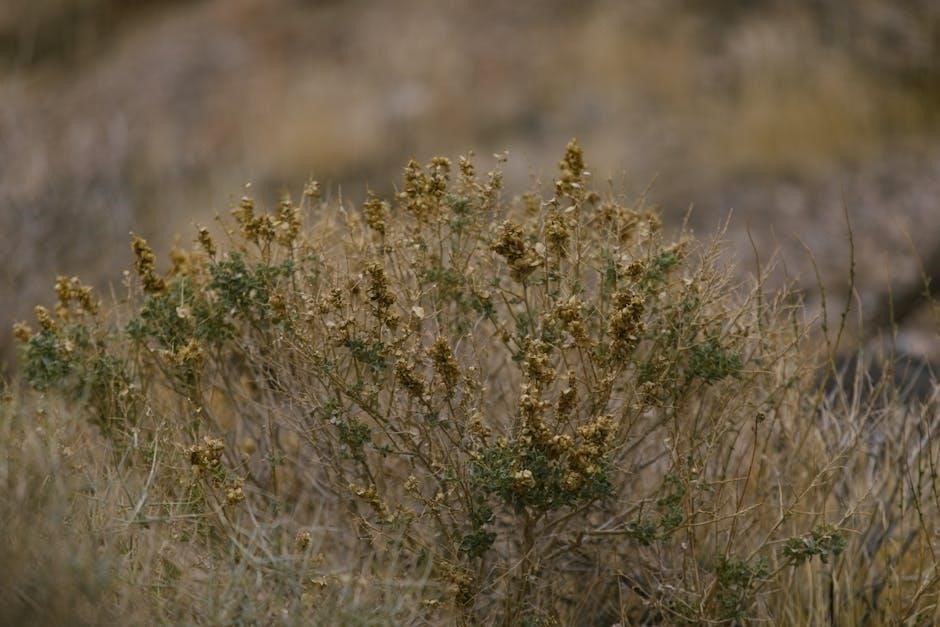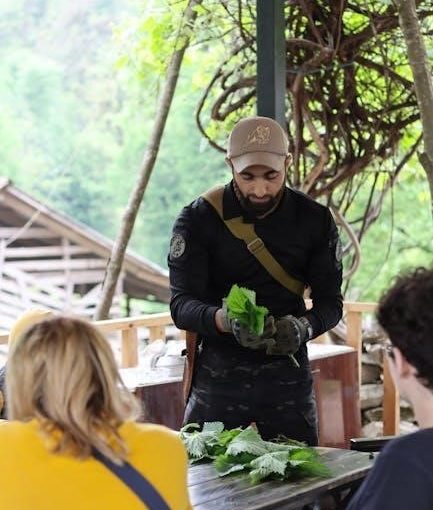Overview of Zone 8b
Zone 8b offers a moderate climate with warm summers and mild winters, making it ideal for growing a wide variety of plants nearly year-round․
Understanding USDA Hardiness Zone 8b
USDA Hardiness Zone 8b is defined by its moderate climate, with warm summers and mild winters․ This zone is characterized by an average annual extreme minimum temperature between 15°F and 20°F (-9°C to -7°C)․ It is part of the USDA Plant Hardiness Zone Map, which helps gardeners determine which plants can thrive in their area․ Zone 8b typically experiences a long growing season, making it ideal for a wide variety of plants, including fruits, vegetables, and flowers․ The last frost date is usually in late March or early April, while the first frost occurs around mid-November, allowing for multiple harvests․ Gardeners in Zone 8b can enjoy planting both cool- and warm-season crops, as well as perennials and herbs, with proper planning․ This zone’s climate supports vibrant gardens year-round with minimal winter protection․

Key Planting Dates for Zone 8b
Zone 8b gardeners can start seeds indoors in late winter and direct sow cool-season crops in early spring, with warm-season crops planted after late spring frosts․
Last Frost Date in Zone 8b
The last frost date in Zone 8b typically occurs around late March, with specific dates varying slightly depending on the region within the zone․
First Frost Date in Zone 8b
The first frost date in Zone 8b generally arrives in late October to early November, signaling the end of the warm growing season․
Vegetables to Plant in Zone 8b
Zone 8b supports a wide variety of vegetables, including cool-season crops like spinach and kale, and warm-season staples such as tomatoes, peppers, and zucchini․
Cool-Season Vegetables for Zone 8b
Cool-season vegetables thrive in Zone 8b’s mild winters and early springs․ These crops prefer cooler temperatures and can tolerate light frosts, making them ideal for fall and early spring plantings․
Popular choices include broccoli, spinach, kale, carrots, radishes, and lettuce․ Plant these in late summer or early fall for a fall harvest, or in late winter to early spring for a spring harvest․ Zone 8b’s long growing season allows for multiple plantings of these resilient crops․ Proper soil preparation and consistent moisture ensure optimal growth․ These vegetables are perfect for gardeners looking to maximize their yield during the cooler months in Zone 8b․
Warm-Season Vegetables for Zone 8b
Zone 8b’s long, hot summers make it perfect for growing warm-season vegetables․ These crops thrive in high temperatures and are planted after the last frost date․
Popular warm-season vegetables include tomatoes, peppers, eggplants, zucchini, corn, and okra․ Start seeds indoors 4-6 weeks before the last frost date for an early start․ Direct sow beans, squash, and melons in late spring․ Ensure soil is well-draining and rich in organic matter․ Full sun exposure is essential for most warm-season crops․ With proper care, these vegetables will flourish, providing a bountiful harvest throughout the summer months in Zone 8b․
Flowers to Plant in Zone 8b
Zone 8b’s moderate climate supports a wide variety of flowers, including vibrant annuals and perennials․ Popular choices like flowering shrubs and colorful perennials thrive in its long growing season․
Spring Bulbs for Zone 8b
Zone 8b’s mild winters and warm springs make it an ideal location for growing a variety of spring bulbs․ Popular choices include crocus, daffodils, and tulips, which thrive in the region’s climate․ These bulbs are typically planted in the fall, allowing them to bloom vibrantly in early spring․ Ensure the soil is well-draining and rich in organic matter for optimal growth․ Plant bulbs at the correct depth, usually 2-3 times their height, and water thoroughly after planting․ Zone 8b’s last frost date in late March signals the start of the blooming season for many spring bulbs․ With proper care, these flowers will add vibrant color and beauty to your garden during the cooler months․
Perennial Flowers for Zone 8b
Zone 8b’s mild winters and warm summers create an ideal environment for growing a variety of perennial flowers․ Popular choices include Hellebores, which bloom in late winter, and Magnolia, Skimmia, and Flowering plum, which thrive in early spring․ These perennials add vibrant color and texture to gardens year-round․ Plant them in well-draining soil rich in organic matter for optimal growth․ Most perennials in Zone 8b should be planted in early spring or fall to establish strong root systems․ Regular watering and mulching are essential to protect plants from extreme heat and retain moisture․ With proper care, these perennials will bloom profusely, enhancing your garden’s beauty throughout the seasons․

Herbs to Plant in Zone 8b
Popular herbs for Zone 8b include basil, rosemary, thyme, mint, oregano, parsley, cilantro, dill, and chamomile․ These herbs thrive in the zone’s mild winters and warm summers, offering fresh flavors year-round․
Popular Herbs for Zone 8b Gardens
Zone 8b gardens thrive with a variety of herbs, including basil, rosemary, thyme, mint, oregano, parsley, cilantro, dill, and chamomile․ These herbs are well-suited to the zone’s mild winters and warm summers, allowing for year-round growth․ Annual herbs like basil and cilantro excel in the region’s warm seasons, while perennials like rosemary and thyme return annually․ Most herbs prefer well-drained soil and full sun, making Zone 8b’s climate ideal․ Planting herbs in containers or directly in the ground offers flexibility․ Many herbs also serve as companion plants, repelling pests and enhancing garden health․ Whether for cooking or medicinal use, these herbs bring flavor and fragrance to Zone 8b gardens․
Herb Growing Tips for Zone 8b
For successful herb gardening in Zone 8b, ensure plants receive full sun (6-8 hours daily) and well-drained soil․ Most herbs thrive in slightly acidic to neutral soil (pH 6․0–7․0)․ Water deeply but avoid overwatering, as this can lead to root rot․ Herbs like rosemary and thyme prefer drier conditions, while mint and chamomile require consistent moisture․ Fertilize lightly in spring with a balanced fertilizer to promote healthy growth․ Prune herbs regularly to encourage bushy growth and prevent flowering․ Divide and replant perennials in early spring for optimal vigor․ Many herbs, such as basil and parsley, can be grown in containers for flexibility․ Companion planting with herbs can enhance flavor and deter pests, making them a valuable addition to Zone 8b gardens․

Gardening Tips for Zone 8b
Plan your garden using Zone 8b planting charts to maximize growth․ Start seeds indoors in late winter for early spring transplantation․ Monitor frost dates to ensure optimal planting times․
Soil Preparation in Zone 8b
Proper soil preparation is essential for a thriving garden in Zone 8b․ Test your soil pH and amend it if necessary, as most plants prefer a slightly acidic to neutral soil pH (6․0–7․0)․ Add organic matter like compost or well-rotted manure to improve soil structure and fertility․ Zone 8b’s warm climate can dry out soil quickly, so mulching around plants helps retain moisture and suppress weeds․ Raised beds are ideal for better drainage and root development․ Incorporate a balanced fertilizer in early spring to provide nutrients for the growing season․ Regularly test your soil to ensure it meets the needs of your plants for optimal growth and productivity․
Companion Planting in Zone 8b
Companion planting is a valuable technique for Zone 8b gardens, enhancing growth and reducing pests․ Pair vegetables like tomatoes with basil and marigolds to deter pests and improve flavor․ Planting nasturtiums near cucumbers and squash repels aphids and whiteflies․ Herbs such as dill and cilantro benefit vegetables by attracting beneficial insects․ Legumes like beans can be paired with corn and squash to create a balanced and nutrient-rich growing environment․ Incorporating flowers like calendula and sunflowers attracts pollinators, boosting overall garden health․ Avoid placing members of the Brassica family (broccoli, kale) near strawberries, as they can hinder growth․ Proper companion planting maximizes space, promotes diversity, and ensures a thriving garden in Zone 8b․

Using a Planting Calendar for Zone 8b
A planting calendar is essential for Zone 8b, helping gardeners maximize the long growing season by timing sowings, transplants, and harvests precisely for optimal results․
Why a Planting Calendar is Essential
A planting calendar is crucial for Zone 8b gardeners to maximize the growing season․ It helps time seed starting, transplanting, and harvesting accurately, ensuring optimal growth and yield․ By following a tailored schedule, gardeners can avoid frosts, make the most of warm weather, and align planting with seasonal changes․ For example, starting cool-season crops like broccoli indoors in February ensures they thrive before summer heat․ Similarly, planting warm-weather crops like tomatoes in May aligns with rising temperatures․ A calendar also aids in crop rotation and spacing, preventing overcrowding and pests․ It ensures gardeners are prepared for each phase, from sowing to harvest, making the process efficient and rewarding․
Zone 8b offers a versatile and rewarding gardening experience with its long growing season and moderate climate․ By understanding the key planting dates, selecting appropriate vegetables, flowers, and herbs, and utilizing essential gardening tips, gardeners can create thriving and productive gardens․ A planting calendar is a valuable tool to maximize yields and ensure plants are well-suited to the local conditions․ Whether growing cool-season crops like broccoli or warm-season favorites like tomatoes, Zone 8b provides ample opportunities for gardeners of all levels․ With proper planning and care, your Zone 8b garden can flourish year-round, offering fresh produce and vibrant beauty throughout the seasons․
